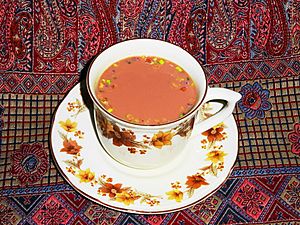Noon chai facts for kids
 |
|
| Alternative names | Noon chai, Kashmiri tea, gulabi chai, pink tea |
|---|---|
| Region or state | Kashmir |
| Associated national cuisine | Kashmiri, Indian, Pakistani, Caribbean |
| Main ingredients | gunpowder tea, milk, soda, salt or sugar |
Sheer chai, also known as Noon Chai or pink tea, is a special kind of tea from Kashmir. It's a traditional drink made with green tea leaves, milk, and a little bit of baking soda. This unique tea often has a beautiful pink color!
Contents
What's in a Name?
The word noon means 'salt' in many Indian languages. These include Kashmiri, Bengali, Hindi, and Nepali. For example, in Rajasthan, people have a custom called noon-dab. This is where a hand is dipped in salt to show a very serious promise.
Some people, like Kashmiri Hindus, call this tea "Sheer chai."
How Pink Tea is Made
Noon chai is usually made with special green tea leaves, milk, salt, and baking soda. It's often cooked in a large pot called a samavar. A tiny bit of baking soda helps give the tea its famous pink color.
Traditionally, people in Kashmir don't add sugar to their homemade Noon chai. However, some restaurants, especially in Pakistan, might add sweeteners. They do this for people who are not used to salty tea.
The Secret to the Pink Color
The pink color comes from a special type of green tea called gunpowder tea. This tea is rolled into small balls. When gunpowder tea is heated to a high temperature, baking soda is added. The baking soda reacts with the tea, creating a deep red or maroon color.
This process is often done a few times. The mixture is cooled with ice and then reboiled. This helps bring out the deep red color even more. When milk is added to this red mixture, it turns a lovely pink! Some shops might use instant mixes or even food coloring to get the pink look, as the traditional method takes a lot of effort.
When and Where it's Enjoyed
Noon chai is a very important part of breakfast and supper in Kashmir. People often drink it with different kinds of traditional Kashmiri bread. It's a creamy, milky tea, and it's usually topped with chopped almonds and pistachios.
This pink tea is popular in North India, especially in Jammu and Kashmir. You can also find it in areas with Tibetan populations, like Mainpat in Chhattisgarh. In Pakistan, it's often served with sugar and nuts during special events, weddings, and in the winter.
During the holy month of Ramadan, Sheer chai is widely sold in places like Patna, Bihar.


